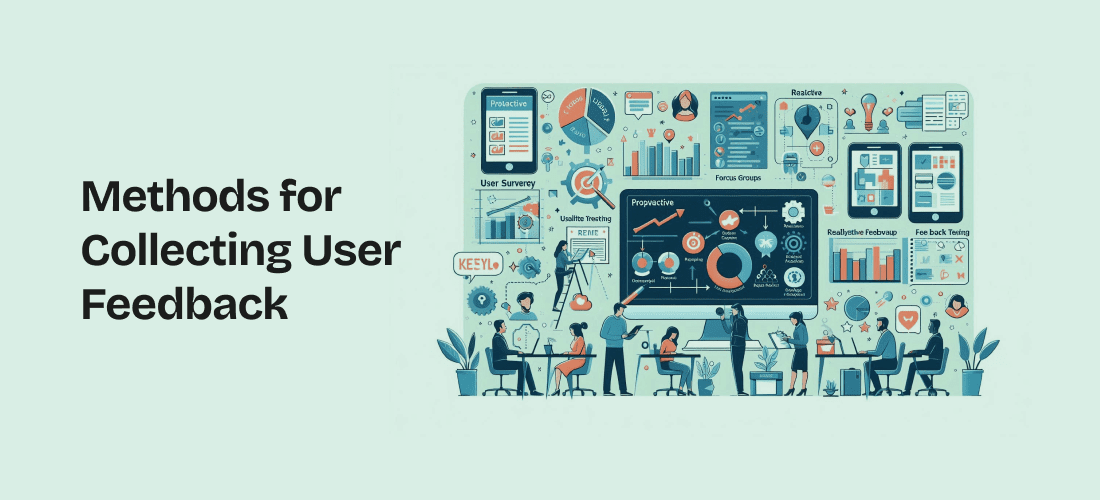
Dec 6, 2024

The process of providing UI UX development services is never truly finished; it’s a continuous process of refining and rebuilding to enhance usability and ensure a seamless user experience. As user needs and behaviors evolve, so too must the design of your app or website. One of the most critical components of this ongoing development process is user feedback. Far from being a side quest, user feedback is essential for identifying pain points, uncovering new opportunities, and driving meaningful improvements. By actively incorporating user insights into your UI UX strategy, you create products that not only meet but exceed user expectations, leading to greater satisfaction and long-term success.
This blog will dive into how user feedback can elevate UI UX development strategy through the incorporation of user feedback. We will talk about the different types of user feedback and the many different tools out there to streamline the collection, organization, analysis, and implementation of user feedback.
User feedback is a cornerstone of effective UI UX development because it provides direct insights from the people who interact with your product. By understanding their experiences, preferences, and pain points, designers can make informed decisions that enhance usability and overall satisfaction. User feedback helps identify issues that may not be apparent during the initial design phase, such as confusing navigation or frustrating features.
Incorporating user feedback fosters a user-centric approach, ensuring that the final product aligns with the needs and expectations of its intended audience. This not only improves the user experience but also increases the likelihood of long-term engagement and loyalty. For a UI UX developer, leveraging user feedback is essential for creating intuitive, efficient, and user-friendly designs that stand out.

Collecting user feedback is essential in UI UX development services for understanding how your design performs in real-world scenarios. There are two primary approaches to gathering this feedback: proactive and reactive methods. Both are valuable for a UI UX development company and using a combination of these methods can provide a comprehensive understanding of user experiences.

Once you’ve collected user feedback, the next step is to effectively incorporate it into the process of UI UX development services. This involves analyzing the feedback to identify key insights, integrating those insights into your design, and continuously testing and refining the design based on user input. Each stage plays a critical role in ensuring that your product evolves in a way that meets user needs and expectations, ultimately leading to a more successful and user-friendly outcome.
Analyzing user feedback is the first crucial step in transforming raw data into actionable insights. A UI UX developer will start by categorizing feedback into themes, such as usability issues, feature requests, or design preferences. This helps in identifying patterns and prioritizing the most impactful changes. The next important step is to distinguish between isolated complaints and widespread concerns—focusing on the latter will yield the most significant improvements. Quantitative data from analytics complements qualitative feedback and provides a fuller picture of user behavior and preferences. By systematically analyzing feedback, the root causes of problems can be easily identified, and user motivations can be understood, enabling informed decisions that enhance the overall user experience.
Once key insights from user feedback have been identified, the next step for a designer of a UI UX development company is to integrate them into the design process. This might involve adjusting the user interface, improving navigation, or adding new features based on user requests. While it’s important to balance user feedback with design principles and business objectives—as user input is invaluable, not all suggestions will align with a brand’s goals or technical feasibility. Collaboration with design and development teams to prioritize changes that will have the most positive impact on the user experience is imperative. Iterative design is key here; by continuously incorporating feedback into successive design iterations, the product evolves in response to real user needs, leading to a more refined and effective outcome.
After incorporating feedback into the design, testing the updated design is crucial for a UI and UX developer, to validate the changes and ensure they effectively address user needs. Then, the process continues where you conduct usability tests and gather additional user feedback on the revised design to identify any remaining issues or new challenges that may have arisen. A/B testing can be particularly useful for comparing different design solutions and determining which performs best with users. In UI UX development services, this iterative process of testing and refining should continue until the design meets the desired usability and performance standards. By consistently refining the design based on user feedback, you create a product that is not only functional but also deeply aligned with user expectations, ultimately enhancing satisfaction and success.

A UI and UX developer relies on a variety of specialized tools to effectively gather, organize, analyze, and implement user feedback. These tools streamline the feedback process, making it easier to translate user insights into actionable design improvements. Below are six key tools commonly used in the industry.
UserTesting allows developers of UI UX development services to observe real users interacting with their products through video recordings and live sessions. This tool provides valuable insights into how users navigate and experience the design, highlighting usability issues that may not be apparent through surveys alone. It’s particularly useful for gathering qualitative feedback and understanding user behavior in real time.
Hotjar is a powerful tool for gathering user behavior data through heatmaps, session recordings, and surveys. It helps designers see where users are clicking, scrolling, and spending the most time, providing insights into how well the design elements are functioning. Hotjar also offers feedback polls and surveys, making it a comprehensive tool for both quantitative and qualitative data.
SurveyMonkey is a popular tool for creating and distributing surveys to gather user feedback. It offers a wide range of question types and analytics tools to help designers understand user preferences, pain points, and satisfaction levels. SurveyMonkey’s robust reporting features allow for easy analysis and identification of trends in user feedback.
Google Analytics is essential for tracking user behavior on websites and apps. It provides detailed reports on metrics like page views, bounce rates, and user demographics. By analyzing this data, designers can identify patterns in user behavior and make informed decisions about which areas of the design may need improvement. Google Analytics is particularly valuable for gathering quantitative feedback on user interactions.
Trello is a project management tool that is often used by UI UX developers to organize and prioritize user feedback. Feedback is categorized into different lists or cards, making it easy to track progress on implementing changes. Trello’s visual board system allows teams to collaborate and ensure that all feedback is addressed in the design process.
Figma is a design tool that also supports collaborative feedback. Designers can share their work with team members and stakeholders who can leave comments directly on the design elements. This real-time feedback integration helps streamline the design process, ensuring that feedback is implemented quickly and efficiently.
Also Read – How Does UI UX Development Help Boost Website Performance?

While user feedback is invaluable in UI UX development services, it comes with its own set of challenges.
Navigating these challenges requires a balanced approach, focusing on key insights that align with both user needs and business goals.
Effectively incorporating user feedback into your design process is essential for creating a final product that truly meets user needs while also enhancing your skills as a developer. By leveraging the right tools and strategies, you can simplify the feedback process, ensuring that every insight contributes to better design. Ultimately, a user-centered approach not only improves the user experience but also drives the success of your UI UX projects.